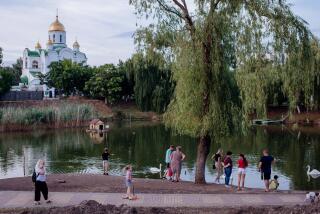SOVIET UNION / SELF-RULE FEVER : The People’s Republic of Udmurt?
MOSCOW — In the hilly, automobile-producing region of Udmurtia, 700 miles east of Moscow, the talk this week has been about proclaiming sovereignty, or perhaps even an “Udmurt People’s Republic.”
In recent weeks, the Tatars who live in the Volga basin have declared their land sovereign, as have the Karelians near the Finnish border and the people of the Komi region of the Far North. The Soviet fever for self-rule that made world headlines when Lithuania declared independence this spring has now spread to the Russian hinterland and to peoples little known in the West.
On Thursday, it became the turn of Udmurtia, a district about half the size of Maine. In the car-making center of Izhevsk, the Udmurt Parliament in extraordinary session proclaimed local resources in the land west of the Urals to be the property of its more than 1.5 million people.
In Izhevsk and elsewhere, more than rhetoric is at stake. As decision-makers in Moscow debate what plan to use to salvage the national economy, leaders of many minorities are concerned that the needs and rights of their out-of-the-way homelands will be trampled.
“Are the rights of the big nations respected, and those of small ones ignored in this country?” Vladislav Ardzinba, a legislator from Abkhazia, asked.
There are 20 “autonomous republics” like Udmurtia and Abkhazia in the Soviet Union, territorial entities that are juridically one notch below the “union republics” such as Russia, the Ukraine or Armenia. Since the days of Josef Stalin, the autonomous republics have been so only in name.
“For example, a union republic is allowed by law to have a film studio, and its own ministries. An autonomous republic cannot, and that’s just ridiculous,” said Ramazan G. Abdulatipov, head of the Council of Nationalities of Russia’s legislature and a native of the autonomous republic of Daghestan.
Despite theoretical autonomy, economic power has remained in outsiders’ hands.
“In Udmurtia, for example, only 10% of the economic resources and apparatus have belonged to the local authorities. The rest has been run from Moscow,” Abdulatipov said.
Keeping the increasingly assertive autonomous republics content in the new political and economic conditions is becoming a major challenge for Abdulatipov, Russian Federation President Boris N. Yeltsin and the rest of the Russian leadership.
Numbers show how important the task is: the Russian republic alone contains 16 autonomous republics, five regions and 10 districts; they total 53.3% of its territory and 17.6% of its people.
These areas range from the diamond-laden Siberian icebox of Yakutia, which covers more than a million square miles of tundra and taiga, to the Adygeisky enclave of 430,000 inhabitants near the sun-drenched shores of the Black Sea.
Leaders of autonomous republics fear the radical economic rescue plan of President Mikhail S. Gorbachev’s protege, Stanislav S. Shatalin, by promising far greater powers to the “union republics,” will leave them to the mercies of the dominant regional ethnic group, which often has few sympathies for their aspirations.
Shatalin’s program, already adopted by the Russian Parliament, “treats us just as ‘local organs of power,’ ” Ardzinba complained in a newspaper interview this week.
An Abkhazian would be understandably concerned. Although Georgia has demanded negotiations with the Kremlin on restoring its independence, more than 20 people died in fighting between Abkhazians and Georgians last year over the pretensions of Abkhazia, which is juridically part of Georgia, to sovereignty for itself.
At Russian government offices by the Moscow River, specialists and lawmakers are pondering a new federal treaty to redefine the Russian republic. Abdulatipov said the aim is to permit maximum home rule and junk the inferior distinctions of “autonomous republic” and others made under Stalin.
More to Read
Sign up for Essential California
The most important California stories and recommendations in your inbox every morning.
You may occasionally receive promotional content from the Los Angeles Times.










